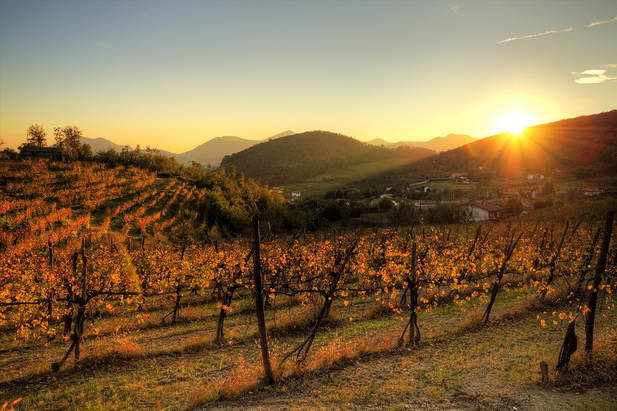ITALY
Aeolian Islands | Aglianico del Vulture, Basilicata | Campania | Colli Euganei | Etna, Sicily
Gattinara | Pitigliano, Tuscany | Soave & Monti Lessini | Vesuvius
Winery
Colli Euganei
From Venice, one can just make out the shadowy tops of the Euganean Hills some 40kms to the west, rising up out of the pastoral Po River Valley. Like an archipelago of steep-sided wooded islands rising from the improbably flat agricultural plain, these hills have been celebrated for centuries for both their picturesque beauty, and the hot springs they harbour. It was here, at Arquà, that celebrated author and poet Petrarch found peace and harmony towards the end of his life. He discovered the village in 1369, and wrote in his letter to posterity, "I have built me a house, small, but pleasant and decent, in the midst of slopes clothed with vines and olives”.
30 million years ago, however, the region was not so peaceful. Violent volcanic activity was ripping open the seabed that covered what is now all of northern Italy, pushing up mounds of basalt through the limestone crust. Today these steep, heavily forested peaks are also home to grapevines in the Colli Euganei DOC.
Two distinct terroirs co-exists. The higher, craggier peaks, ranging from 300m to 600m above the Padovan-Venetian plain, are composed of weathered, crumbling lava that successfully broke through the sea floor, eventually becoming exposed as the sea receded. The lower lying, rolling hills, on the other hand, were formed by pockets of pressurized magma that pushed up, but did not break through, the earth’s crust. Here, soils are composed of the typical chalky-limestone parent material found in regions that were formerly under sea.
Over two-dozen wine styles and fifteen varieties are covered under the Colli Euganei appellation and its 700 or so hectares of vineyards. But the region’s best known signature is easily the Fior d'Arancio, a gently sweet, highly fragrant wine made from moscato giallo and bianco. Fittingly, these wines were promoted to their own DOCG in 2010.
Merlot, Cabernet Sauvignon and Cabernet Franc have a significant presence here, as they do across Veneto, as does Carmenere, continuing to surge in popularity across northeastern Italy. Local varieties Raboso, Tai, Manzoni Bianco, Friulano, Pinella and Serprino (the local name for the Prosecco grape) are also made into varietal wines, as are the reliably marketable favorites Chardonnay and Sauvignon.


